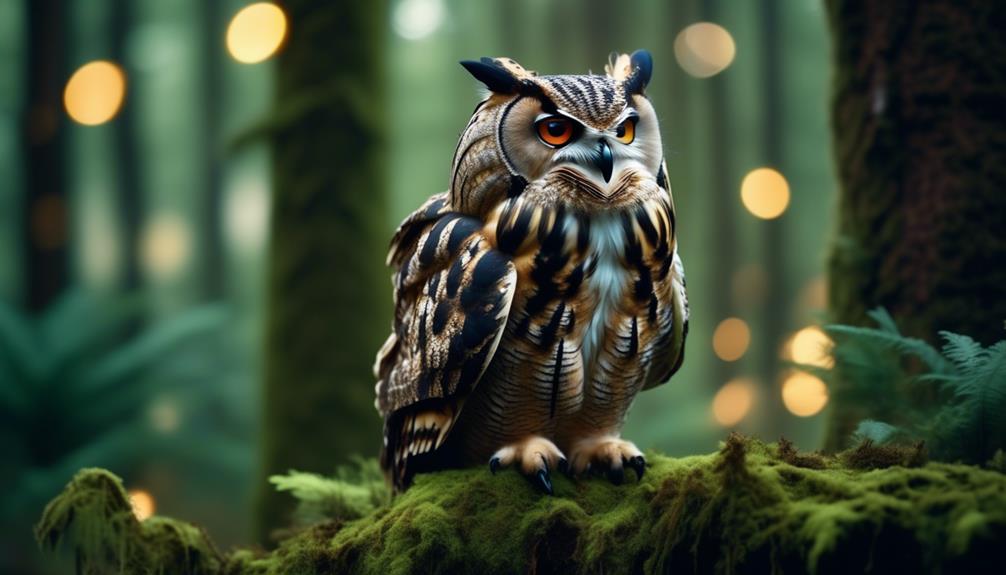They say that wisdom comes in many forms, and in the case of the majestic owls that inhabit the skies of France, this couldn’t be truer.
As you venture into the world of these fascinating creatures, you’ll be captivated by their unique characteristics and behaviors. From the enchanting Short-Eared Owl to the magnificent Eurasian Eagle Owl, there are nine owl species that call France their home.
But that’s just the beginning. In this article, we will unravel the mysteries and unveil the wonders of these owls, providing you with species identification, intriguing facts, and captivating pictures.
Get ready to embark on a journey through the owl kingdom, where surprises await at every turn.
Short-Eared Owls (Flammeus)
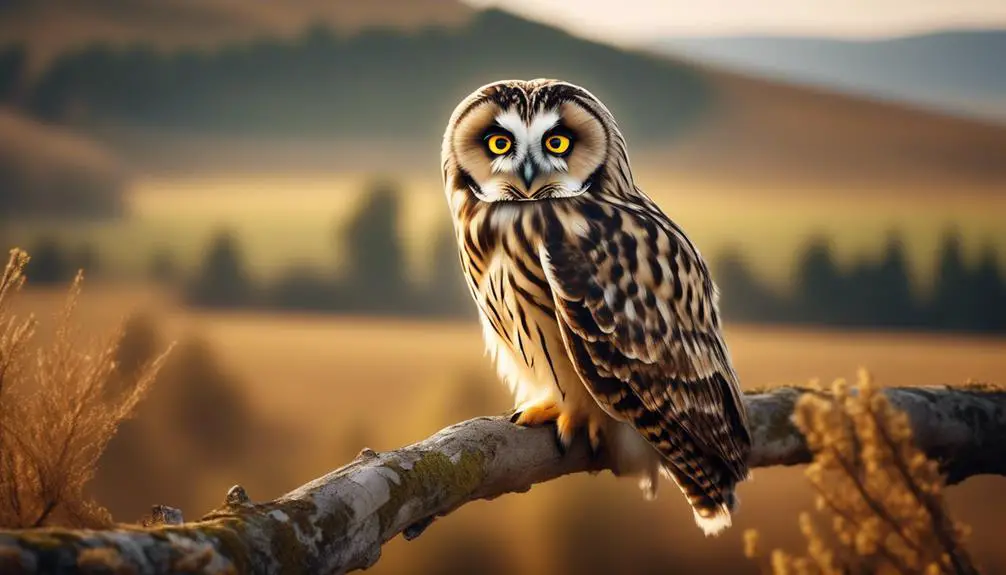
Short-Eared Owls (Flammeus), known for their distinct physical features and habitats, are a fascinating species of owls found in France. These owls are easily recognizable by their short ear tufts, which aren’t actually ears but rather feathers that stick out from the top of their heads. They’ve large, round faces with yellow eyes, and their feathers are a mix of white, brown, and cream, which helps them blend in with their grassland and meadow habitats. Short-Eared Owls have a wingspan of about 54-58cm and weigh between 140-220g.
These owls prefer open areas such as savannahs, marshes, and dunes, as well as agricultural areas with low vegetation. They’re often seen flying low to the ground, searching for small mammals such as mice and voles, which make up the majority of their diet. Short-Eared Owls are also known for their unique hunting behavior of hovering in the air, similar to that of a kestrel, before swooping down to catch their prey.
In France, Short-Eared Owls are a common sight during the breeding season, which typically takes place from March to July. They build their nests on the ground, often in tall grasses, and lay a clutch of 4-7 eggs. Both the male and female take turns incubating the eggs and caring for the chicks once they hatch.
Long-Eared Owls (Hibuo More-Duc)
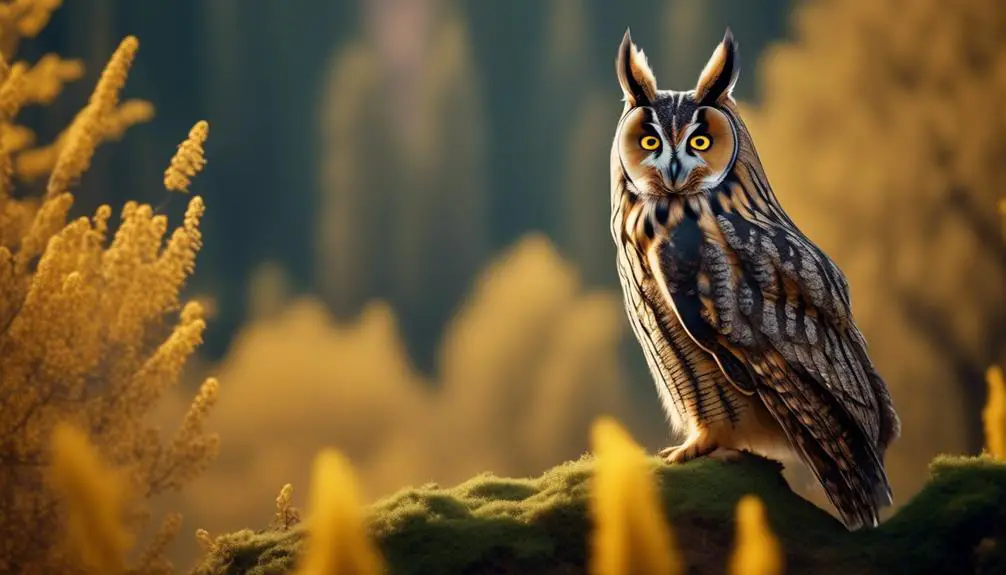
During the breeding season in France, another fascinating species of owl can be found: the Long-Eared Owls (Hibuo More-Duc). These owls are known for their distinctive long ear tufts, which are actually just feathers and not ears at all. Despite their name, Long-Eared Owls have average-sized ears located on the sides of their heads.
Long-Eared Owls are medium-sized owls, with males measuring around 35-39cm and females slightly larger at 37-41cm. They’ve a wingspan of 84-95cm and weigh between 210-370g. Their coloration varies, but they often have orange, grey, black, cream, and brown feathers, which help them blend in with their woodland habitat.
These owls prefer living in woodlands, conifer groves, and forests where they can find suitable nesting sites. They’re nocturnal hunters and feed mainly on small mammals like mice and voles, as well as birds and insects.
During the breeding season, Long-Eared Owls form monogamous pairs and nest in trees, using abandoned crow or magpie nests. The female lays 3-8 eggs and incubates them for around 24-26 days. The male provides food for the female and the chicks.
Long-Eared Owls are generally not aggressive towards humans, but they can become defensive if their nest or young are threatened. It’s important to respect their habitat and avoid disturbing them during this sensitive time.
Little Owl (Chevêche D’athèna)
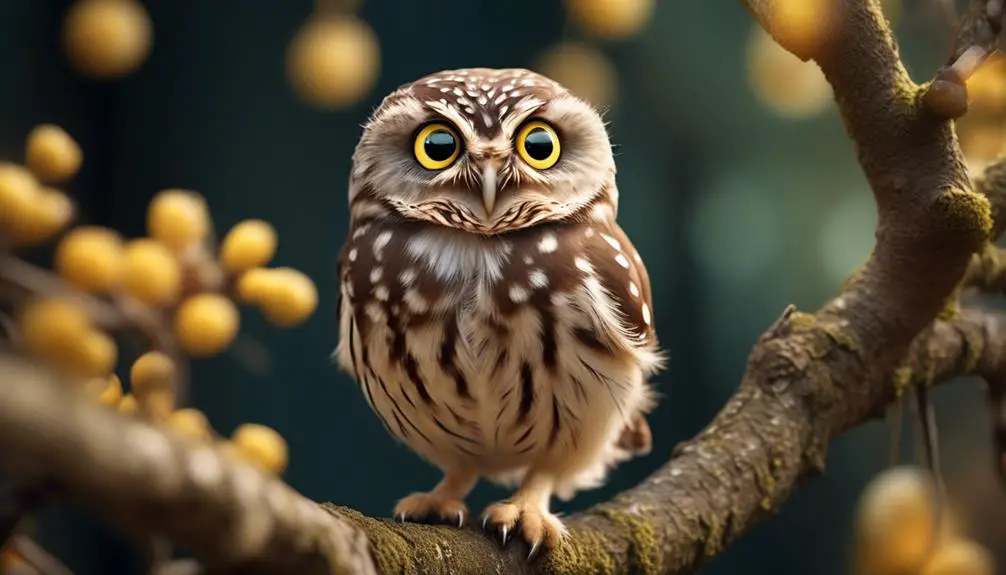
The Little Owl, also known as Chevêche D’athèna, is a small owl species found in France. These owls are known for their petite size, measuring approximately 21-23cm in length and weighing around 140-222g. With a wingspan of about 54-58cm, they’ve the ability to soar through the French skies with ease.
The Little Owl is characterized by its distinctive appearance. It has a round, flat face with large, bright yellow eyes. Its plumage is a combination of white, brown, and cream, providing excellent camouflage in its natural habitat. These owls are often found in lowland farmland, parkland, and orchards, where they can easily blend in with their surroundings.
Despite their small size, Little Owls are skilled hunters. They primarily feed on insects, small mammals, and birds. Their hunting technique involves perching on a high vantage point and swooping down to catch their prey.
In terms of behavior, Little Owls are known for their territorial nature. They’ll fiercely defend their nesting sites from intruders, often emitting harsh calls as a warning.
The conservation status of the Little Owl in France is currently stable. However, habitat loss and changes in agricultural practices pose potential threats to their population. Efforts are being made to protect their habitats and raise awareness about their importance in the ecosystem.
Tawny Owl (Chouette Hulotte)
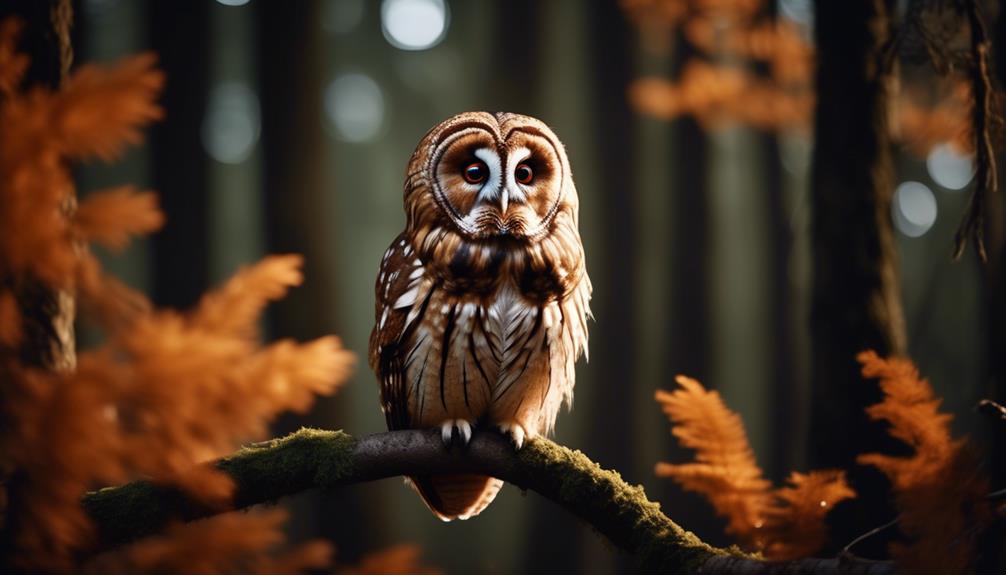
You may often encounter the Tawny Owl, also known as Chouette Hulotte, during nighttime explorations in the woodlands and urban areas of France. This medium-sized owl is easily recognizable by its distinctive appearance.
The Tawny Owl measures between 37-40cm in length and has a wingspan of 94-105cm. With its white and brown plumage, it blends seamlessly into its natural surroundings.
The Tawny Owl is a versatile species that can adapt to various habitats, including farmland, urban areas, and woodland. It’s known for its distinctive hooting call, which can often be heard during the night.
This owl is a skilled hunter, preying on small mammals, birds, and insects. It hunts silently, using its sharp talons and excellent hearing to locate its prey.
The Tawny Owl is also known for its fierce territorial behavior, defending its nesting sites vigorously. Encounters with these owls can be a thrilling experience, but it’s important to respect their habitats and observe from a safe distance.
Eurasian Eagle Owl (Hibuo Grand Duc)
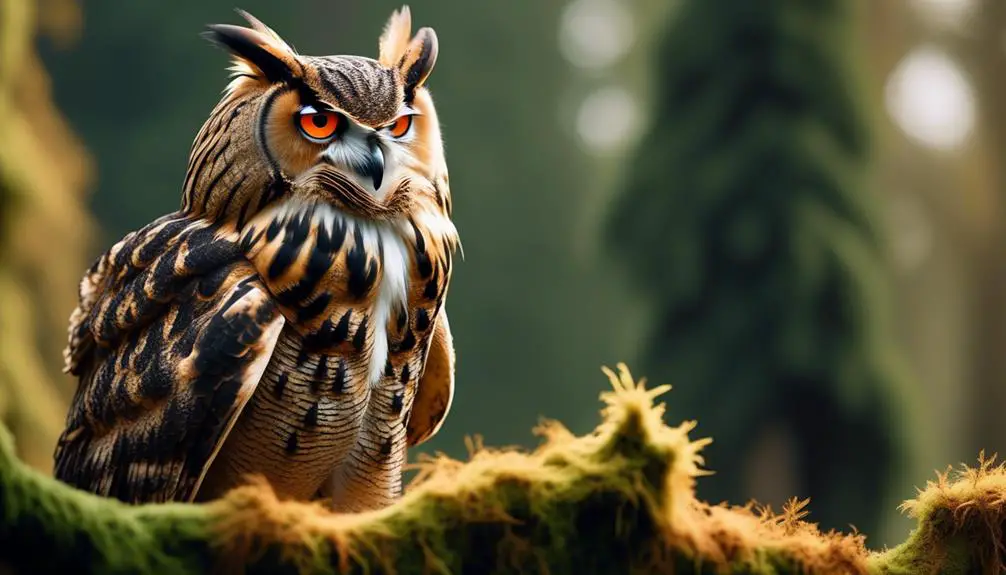
As you continue your nighttime explorations in the woodlands and urban areas of France, another captivating owl species to encounter is the Eurasian Eagle Owl, also known as Hibuo Grand Duc. With its impressive size and striking appearance, the Eurasian Eagle Owl is the largest owl species in Europe. It measures around 69-75cm in length, weighs between 1.5-4kg, and has a wingspan of 155-180cm.
This owl is characterized by its brown, white, and black plumage, which provides excellent camouflage in its preferred habitats of woodlands, deserts, mountains, open grassland, and river beds.
The Eurasian Eagle Owl is a powerful predator, capable of taking prey as large as foxes and small deer. Its diet mainly consists of mammals like rabbits, rodents, and birds. You may even come across the remains of its prey, such as feathers and bones, near its roosting or nesting sites.
Despite its size and hunting prowess, this owl is generally not a threat to humans and will typically avoid confrontation. However, it’s important to respect its territory and avoid disturbing its nesting sites to ensure a safe encounter.
When you spot the Eurasian Eagle Owl, take a moment to appreciate its majestic presence and the unique opportunity to witness one of France’s most impressive nocturnal predators.
Barn Owl (Tyto alba)
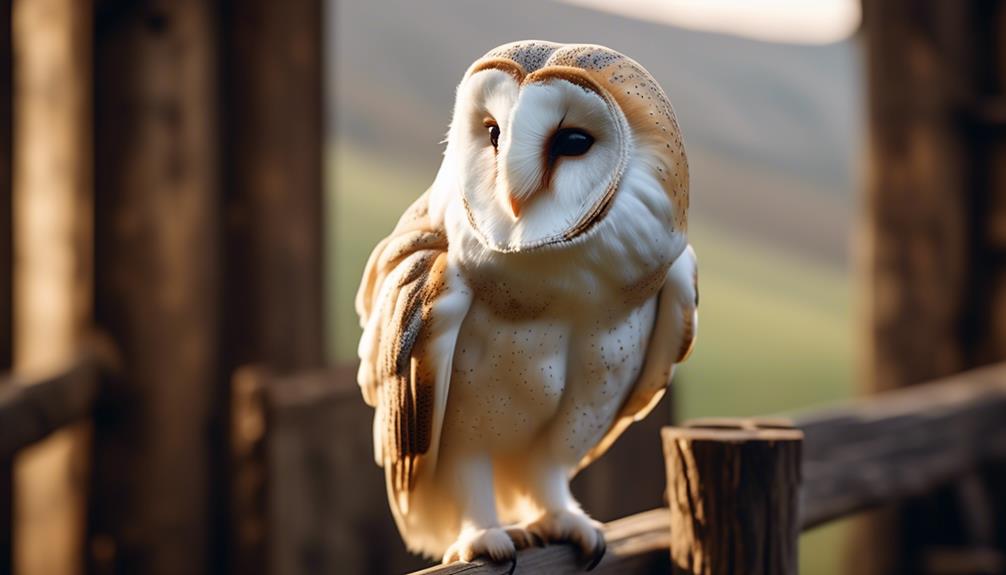
With its distinctive pale grey beak, white facial discs, and mostly grey feathers, the Barn Owl (Tyto alba) is a captivating sight in the woodlands and farming habitats of France. This owl species, known for its heart-shaped face and long wings, measures between 29 to 44 cm in length and has an impressive wingspan of 80 to 95 cm. The Barn Owl is one of the birds with the highest geographical spread worldwide, making it a common presence in France.
Encounters with Barn Owls in France aren’t uncommon, especially while jogging in woodlands or forests. However, it’s important to note that these owls aren’t dangerous to humans unless provoked. Cases of attacks by owls in France are rare, but it’s possible for a Barn Owl to attack if its territory, young ones, or mates are encroached upon. Therefore, it’s crucial to respect their habitats and ensure safety when encountering them.
In France, the Barn Owl primarily inhabits farming habitats, spinneys, and ditches. These birds play a significant role in controlling rodent populations, making them beneficial to farmers. By hunting small mammals such as mice and voles, they help maintain a balance in agricultural ecosystems.
The Barn Owl’s presence in the woodlands and farming habitats of France adds to the natural beauty and biodiversity of the country. Their distinct appearance and graceful flight make them a cherished sight among nature enthusiasts and birdwatchers. So, keep an eye out for these captivating creatures during your outdoor adventures in France.
Owl Size, Weight, and Wingspan
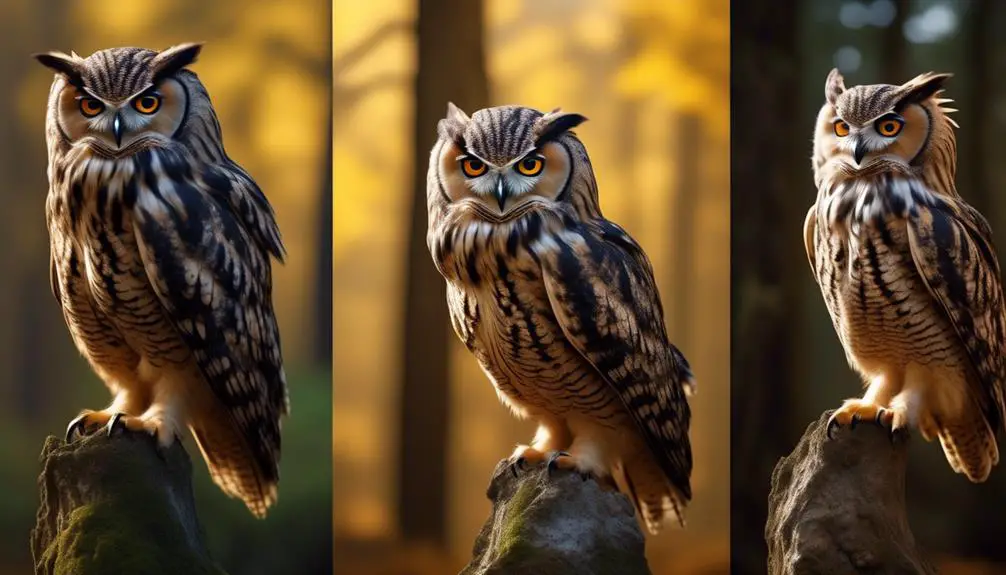
The size, weight, and wingspan of owls vary among different species, providing fascinating insights into their physical characteristics.
For example, the Short-Eared Owl measures around 21-23cm in length and has a wingspan of 54-58cm. It weighs between 140-220g.
On the other hand, the Long-Eared Owl is slightly larger, with males measuring 35-39cm and females measuring 37-41cm in length. They have a wingspan of 84-95cm and weigh between 210-370g.
The Tawny Owl measures 37-40cm in length and has an impressive wingspan of 94-105cm. It weighs between 330-580g.
The Eurasian Eagle Owl is the largest owl species found in France, measuring 69-75cm in length and weighing between 1.5-4kg. It has a wingspan of 155-180cm.
Lastly, the Barn Owl measures 32-40cm in length and weighs between 400-700g. While its wingspan isn’t specified, it’s known for its unique short tail and heart-shaped face.
Understanding the size, weight, and wingspan of owls helps us appreciate their physical capabilities and adaptability to different environments.
Owl Colors and Physical Features

Now let’s shift our focus to the fascinating world of owl colors and physical features, exploring the unique characteristics that make each owl species in France truly captivating.
Owls come in a variety of colors, ranging from white, brown, cream, and orange to grey, black, and buff. These colors help them blend into their surroundings and remain hidden from predators or prey.
Additionally, owls exhibit distinct physical features that contribute to their charm. They have large, round heads with forward-facing eyes, enabling them to have exceptional binocular vision. Their facial discs, composed of feathers, help to direct sound towards their ears, allowing them to accurately locate their prey.
Furthermore, owls have sharp, curved beaks and powerful talons that they use to catch and kill their prey. They also possess specialized feathers that allow for silent flight, enabling them to hunt stealthily.
Each owl species in France possesses its own unique combination of colors and physical features, making them truly mesmerizing creatures to observe in the wild.
Owl Habitats and Scientific Names
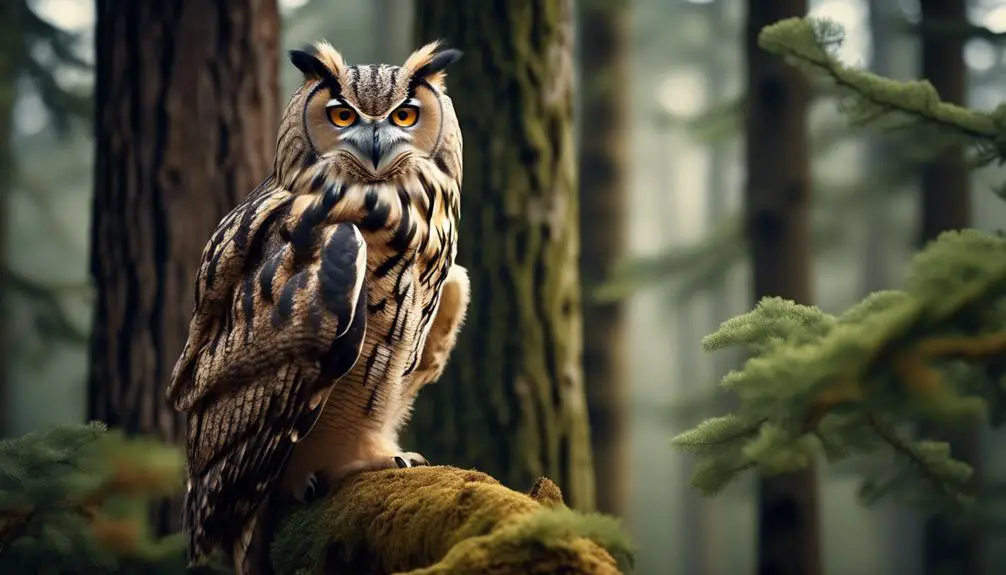
Exploring the diverse habitats and scientific names of owls in France reveals the fascinating environments in which these captivating creatures thrive.
Short-Eared Owls, known as Asio flammeus, can be found in grasslands, low vegetation, savannahs, meadows, marshes, dunes, and agriculture areas.
Long-Eared Owls, scientifically named Asio otus, prefer woodland, conifer groves, and forests.
The Little Owl, Athene noctua, can be spotted in lowland farmland, parkland, and orchards.
Tawny Owls, scientifically known as Strix aluco, are commonly found in farmland, urban areas, and woodland.
The Eurasian Eagle Owl, Bubo bubo, thrives in woodlands, deserts, mountains, open grassland, and river beds.
The Barn Owl, Tyto alba, is typically found in farming habitats, spinneys, and ditches.
These scientific names not only help identify each owl species but also provide insight into their particular habitats. Each owl species has adapted to its specific environment, showcasing the remarkable adaptability of these birds. From the grasslands to the woodlands, owls in France have found their niche and flourish in their respective habitats. Whether it’s the open fields or the dense forests, these creatures have adapted to survive and thrive in a range of different ecosystems.
Understanding the habitats of owls in France is crucial for their conservation and protection. By recognizing their preferred environments, we can work towards preserving these habitats and ensuring the survival of these fascinating creatures.

Erzsebet Frey (Eli Frey) is an ecologist and online entrepreneur with a Master of Science in Ecology from the University of Belgrade. Originally from Serbia, she has lived in Sri Lanka since 2017. Eli has worked internationally in countries like Oman, Brazil, Germany, and Sri Lanka. In 2018, she expanded into SEO and blogging, completing courses from UC Davis and Edinburgh. Eli has founded multiple websites focused on biology, ecology, environmental science, sustainable and simple living, and outdoor activities. She enjoys creating nature and simple living videos on YouTube and participates in speleology, diving, and hiking.
- WILDLIFE THEMED T-SHIRTS
Cute Hedgehog Embroidered: Love Wildlife, Protect Nature Wildlife conservation tees
$35.00

